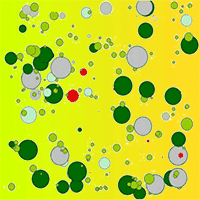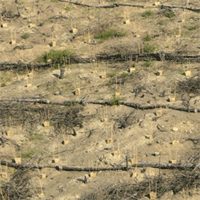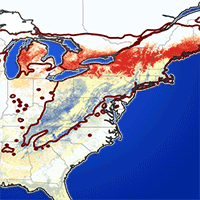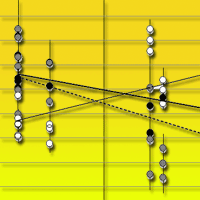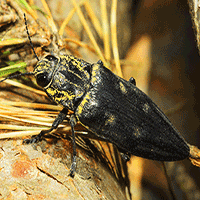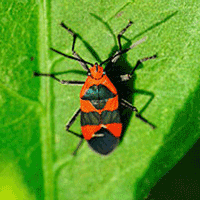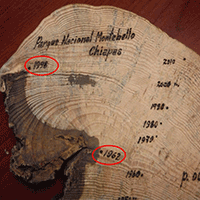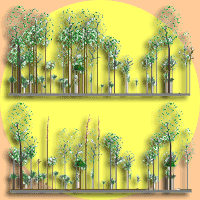
Evaluating short term simulations of a forest stand invaded by emerald ash borer
Abe Levin-Nielsen, Lynne K Rieske
iForest - Biogeosciences and Forestry, Volume 8, Issue 1, Pages 19-24 (2015)
doi: https://doi.org/10.3832/ifor1163-007
Published: May 26, 2014 - Copyright © 2015 SISEF
Research Articles
Abstract
The invasive emerald ash borer (Agrilus planipennis - EAB) is causing rapid and widespread ash (Fraxinus spp.) mortality in eastern North America, has established populations near Moscow, Russia, and is threatening ash resources in Europe. Given the prevalence of susceptible hosts these post-invasion forests will clearly differ from their pre-invasion counterparts. Understanding these changes is key to mitigating the impacts of invasion and developing sound management strategies. We evaluated short term changes in a forest stand invaded by EAB, and examined if the southern variant of the Forest Vegetation Simulator (FVS) could accurately predict those changes. Through simulation, managers can gain a clearer understanding of how pest invasions impact and alter future forest dynamics. However, many simulators are designed to achieve long-term predictions and thus do not align with the short term changes associated with rapid EAB-induced ash mortality. Woody vegetation was surveyed in 2010 and used to project impacts of EAB invasion into 2012 by simulating a 50% ash mortality rate. The same plots were then re-surveyed in 2012, allowing us to evaluate: (1) changes in actual forest composition and structure; and (2) simulation accuracy. Within our forest stand, FVS accurately estimated short term changes in stem density and basal area parameters, thus demonstrating its value as a short-term simulator for EAB-induced changes within the southern region of the United States. EAB-induced ash mortality is quickly changing these forests and will ultimately alter how stakeholders manage their lands. We discuss the potential usefulness of FVS as a tool for aiding management decisions in response to EAB invasion.
Keywords
Ash, Forest Succession, Modeling, Forest Vegetation Simulator
Authors’ Info
Authors’ address
Lynne K Rieske
Department of Entomology, University of Kentucky, S-225 Agricultural Science Center North, 40546-0091 Lexington, KY (USA)
Corresponding author
Paper Info
Citation
Levin-Nielsen A, Rieske LK (2015). Evaluating short term simulations of a forest stand invaded by emerald ash borer. iForest 8: 19-24. - doi: 10.3832/ifor1163-007
Academic Editor
Massimo Faccoli
Paper history
Received: Oct 23, 2013
Accepted: Apr 02, 2014
First online: May 26, 2014
Publication Date: Feb 02, 2015
Publication Time: 1.80 months
Copyright Information
© SISEF - The Italian Society of Silviculture and Forest Ecology 2015
Open Access
This article is distributed under the terms of the Creative Commons Attribution-Non Commercial 4.0 International (https://creativecommons.org/licenses/by-nc/4.0/), which permits unrestricted use, distribution, and reproduction in any medium, provided you give appropriate credit to the original author(s) and the source, provide a link to the Creative Commons license, and indicate if changes were made.
Web Metrics
Breakdown by View Type
Article Usage
Total Article Views: 53885
(from publication date up to now)
Breakdown by View Type
HTML Page Views: 45332
Abstract Page Views: 3213
PDF Downloads: 3752
Citation/Reference Downloads: 76
XML Downloads: 1512
Web Metrics
Days since publication: 4216
Overall contacts: 53885
Avg. contacts per week: 89.47
Citation Metrics
Article Citations
Article citations are based on data periodically collected from the Clarivate Web of Science web site
(last update: Mar 2025)
Total number of cites (since 2015): 4
Average cites per year: 0.36
Publication Metrics
by Dimensions ©
Articles citing this article
List of the papers citing this article based on CrossRef Cited-by.
References
Natural resource information service (NRIS): field sampled vegetation (FSVeg) common stand exam (v. 1.5.1). Rocky Mountain Research Station, USDA Forest Service, Fort Collins, CO, USA, pp. 6.
Gscholar
Emerald ash borer (Agrilus planipennis) density and canopy dieback in three North American ash species. Arboriculture and Urban Forestry 33: 338.
Gscholar
Silvics of North America: Volume 2. Hardwoods. USDA Forest Service Agricultural Handbook 654, Washington, DC, USA, pp. 335.
Gscholar
The relationship between the emerald ash borer (Agrilus planipennis) and ash (Fraxinus spp.) tree decline: using visual canopy condition assessments and leaf isotope measurements to assess pest damage. Forest Ecology and Management 303: 143-147.
CrossRef | Gscholar
Native bark-foraging birds preferentially forage in infected ash (Fraxinus spp.) and prove effective predators of the invasive emerald ash borer (Agrilus planipennis Fairmaire). Forest Ecology and Management 313: 300-306.
CrossRef | Gscholar
Canopy gaps and the dynamics of a neotropical forest. In: “Plant ecology” (Crawley M ed). Blackwell, Oxford, UK, pp. 77-96.
Gscholar
Green ash. In: “Silvics of North America (vol 2). Hardwoods” (Burns RM, Honkala BH). Agricultural Handbook 654, USDA Forest Service, Washington, DC, USA, pp. 348.
Gscholar
Ash (Fraxinus spp.) mortality, regeneration, and seed bank dynamics in mixed hardwood forests following invasion by emerald ash borer (Agrilus planipennis). Biological Invasions 16 (4): 859-873.
CrossRef | Gscholar
American wildlife and plants, a guide to wildlife food habits: the use of trees, shrubs, weeds, and herbs by birds and mammals of the United States. Courier Dover Publications, New York, USA, pp. 359.
Gscholar
White ash. In: “Silvics of North America (vol. 2). Hardwoods” (Burns RM, Honkala BH). Agricultural Handbook 654, USDA Forest Service, Washington, DC, USA, pp. 333.
Gscholar
Forest of the future: simulating the effects of exotic invasive species on forest structure and composition. MS thesis, Department of Entomology, University of Kentucky, Lexington, KY, USA, pp. 99.
Gscholar
Trees and shrubs of Kentucky. University of Kentucky Press, Lexington, KY, USA, pp. 582.
Gscholar

